Last Updated on April 25, 2023
Blue Heeler Lab mixes have the best traits of their parent breeds – smart, loyal, active. These dogs will work their way into your heart!
They also go by other nicknames like Labraheeler, Cattle Dog Labs, or Australian Cattle Dog Lab mix.
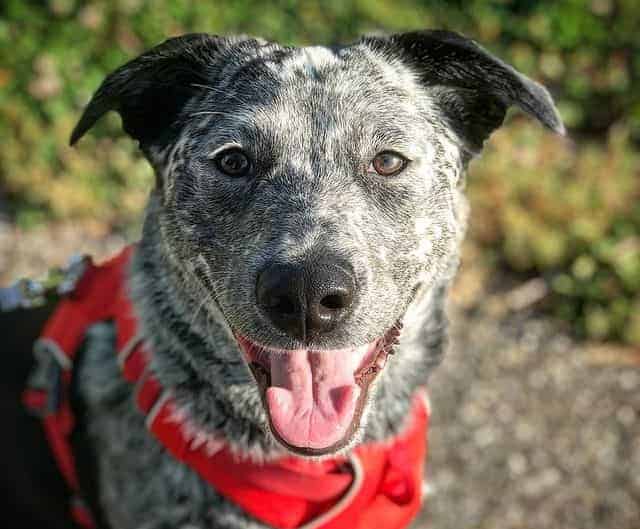
Will you get this crossbreed, though? Read on to find out if you can handle this canine’s personality, size, and care requirements.
Quick Navigation
- 1 What is a Labraheeler?
- 2 What does a Blue Heeler Lab mix look like?
- 3 Is the Blue Heeler Lab mix a good family dog?
- 4 Caring for a Blue Heeler Lab mix
- 5 Lifespan: Are Australian Cattle Dog Lab mixes healthy?
- 6 How much do Labraheelers cost?
- 7 Other Blue Heeler mixes and Labrador hybrids
- 8 Make the Blue Heeler Lab mix a part of your life
- 9 Reference
What is a Labraheeler?
This hybrid is a mix between a Blue Heeler and a Labrador Retriever, though their origin isn’t exactly clear.
They’re probably bred to produce a canine with less health problems compared to its purebred parents while strengthening their signature qualities.
Some people love the intelligent, active Blue Heeler, but they wanted to work in a bit of the loyal, friendly Labrador Retriever, and the rest is history.
The downside with mixed breeds is you never know exactly what you’ll get since they can inherit any variety of traits – both appearance and temperament – from their parents.
Here are the facts: this dog is a mix of a yellow labrador, a black lab, or a chocolate lab with a blue heeler. You may also see a labrador mixed with a red heeler.
To really understand this dog, you need to know a bit about the two breeds that it’s made up of.
The versatile Labrador Retriever

The Labrador Retriever comes from 1800s Britain. It was bred to be a water retriever that works closely with its humans all day long. That means they’re generally loyal and people-oriented. They also like to have a job.
On average, labs are 21 to 25 inches (53 to 63.5 cm) tall at the shoulder and 55 to 80 pounds (25 to 36 kg). Females are slightly smaller than males. They have a short, dense coat that comes in a range of yellows, black, or chocolate.
They are consistently one of the most popular dogs in the U.S., partially because they are so friendly and willing to please. There are both English and American types of labs, but both are basically the same.
The hardworking Blue Heeler
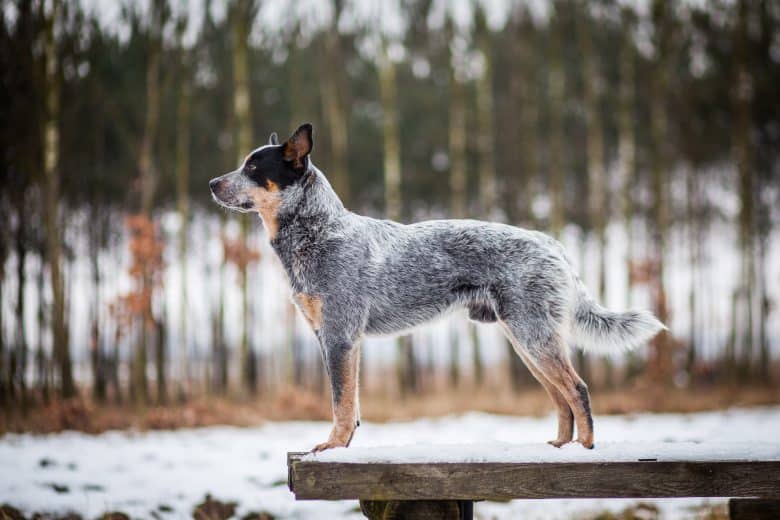
Blue Heelers, or Queensland Heelers, are most commonly known as the Australian Cattle Dog.
Bred in Australia, this wild Aussie dog is said to be a combination of Dingoes, Scottish Highland Collies, Dalmatians, and Kelpies, to help them adapt and work in the rough interior of the country alongside cattlemen.
The first recognized Heeler was established in the 1800s and was admitted to the American Kennel Club’s (AKC) Herding Group in 1983.
These dogs are about 17 to 20 inches (43 to 51 cm) at the shoulder and 35 to 50 pounds (16 to 23 kg). They are muscular, with a short, speckled coat.
Unlike Labs, the Australian Cattle Dog can be standoffish and stubborn, but they’re intensely loyal and highly energetic.
What does a Blue Heeler Lab mix look like?
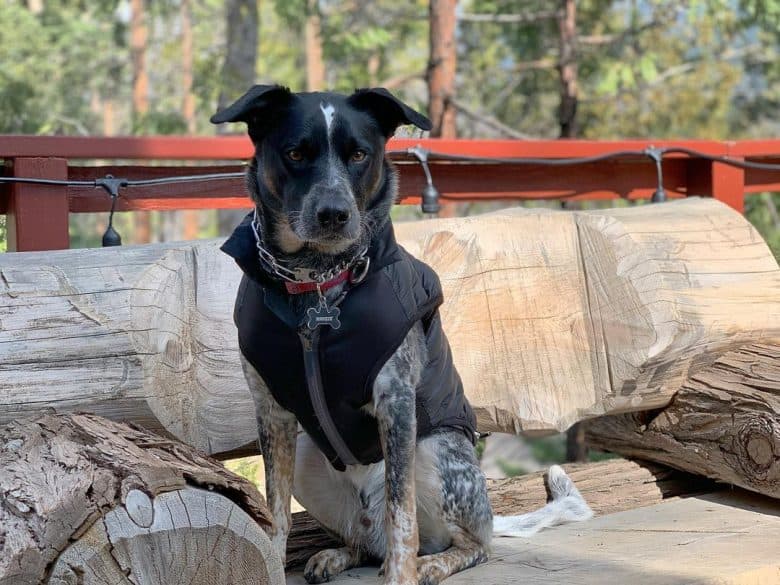
There’s no predicting your hybrid pup’s exact physical traits. They could look very similar to a yellow lab, they may resemble a heeler, or they could be a perfect combo of the two.
Blue Heeler Lab mixes have a stocky build with eyes that can be blue, hazel, and brown. Some have a different color in each eye. Its nose can be quite unique, too. It can either be black, brown, or isabella.
Generally, they have a thick double-coat – a short and stiff topcoat, then a weather-resistant undercoat.
You may usually find a Labraheeler with a solid color coat that has red- or blue-speckled cream or dark markings. But they also come in different combinations such as black and white, blue, red, black, yellow, chocolate, or a mix, with or without ticking.
Whichever coat color your dog may have, there’s often some white mixed in, usually around the face or feet.
This video shows what a Blue Heeler Lab mix puppy can look like. Pretty cute, right?
Size: How big will a Blue Heeler Lab mix get?
Not as big as you think. A full-grown Cattle Dog Lab mix can reach a size of about 16 to 25 inches (41 to 63.5 cm) at the shoulder and 26.5 to 80 pounds (12 to 36 kg).
Keep in mind that they can be on the smaller or larger side of the scale, depending on if it takes after the Labrador or Blue Heeler.
Although they have a small or medium-size version, this crossbreed isn’t suitable for apartment-living.
Taking into consideration the energy level and background of this fido’s parents, they’ll thrive in a rural setting that offers a lot of space to roam freely.
Is the Blue Heeler Lab mix a good family dog?
This hybrid is usually an excellent family dog, but there are certain factors to think of.
Labraheelers are intelligent, loyal, affectionate with their humans. They may be more stand-offish and stubborn like Aussie Cattle Dogs, so be prepared for that. They might also be incredibly goofy, sweet, and friendly like a Lab.
If you’re planning to get this designer dog as a pet, they can have an urge to herd and guard and be suspicious of new people. Blue Heelers tend to be aggressive if not trained early and properly, which is why socialization should be a priority.
Keep an eye on your Labraheeler when she’s around other pets because she may try to herd or hunt them.
With that said, we recommend this pooch for active families with older children. While they may not necessarily be aggressive, the herding, bouncing, and general activity can be dangerous for little ones.
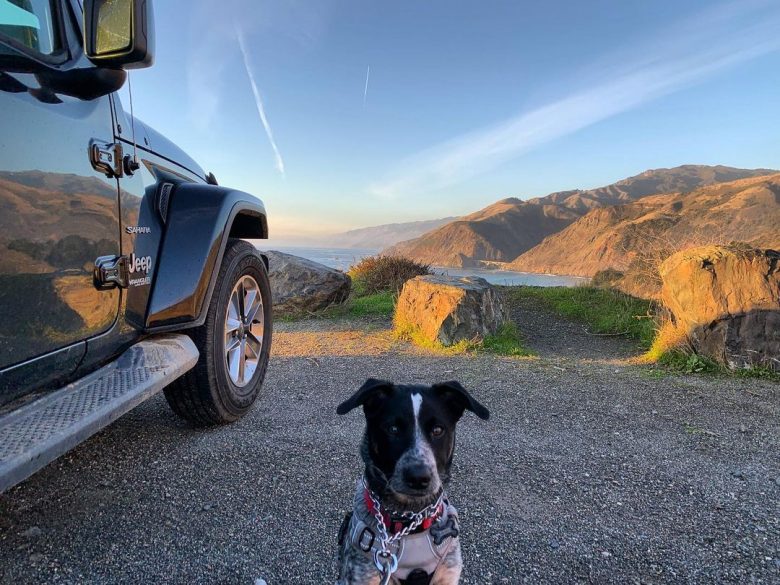
If hiking, swimming, paddle boarding, biking, running, and even horseback riding, are some of the activities you enjoy, then a Blue Heeler Lab mix will gladly join you.
When training or teaching your pet to socialize, regardless if it’s a pup or an older dog, they need to be exposed to new noises, sights, smells, and places regularly. Keep it positive so that they learn to like new experiences.
The other rule of thumb is to be consistent. If they don’t think they can trust you to be the leader, they may just decide to take over the job for you. They need to see that you are consistently in charge and that you mean what you say.
You can’t let a Labraheeler get bored, or she can become destructive. Your fur buddy has an active mind that likes to solve problems.
Keep challenging her by playing games like hide and seek or give them puzzles with hidden treats to keep them entertained.
Clicker training works particularly well for this mixed breed. It’s when you use a small tool that makes a clicking sound to indicate that your dog did a good job. No click, no reward – whether that’s your praise or a treat.
They don’t like to be left alone, either, and training may help avoid separation anxiety.
Do this by praising your dog and giving her a treat before leaving the house, and then being calm and matter-of-fact when you return. This tells them that it is no big deal that you are gone.
Gradually extend the time that you are away until the dog can handle several hours at a time. But if you need to leave the house to commute and work in an office for 8 hours a day, this isn’t the right dog for you.
They’re much too active and intelligent to be left alone that long every day.
Caring for a Blue Heeler Lab mix
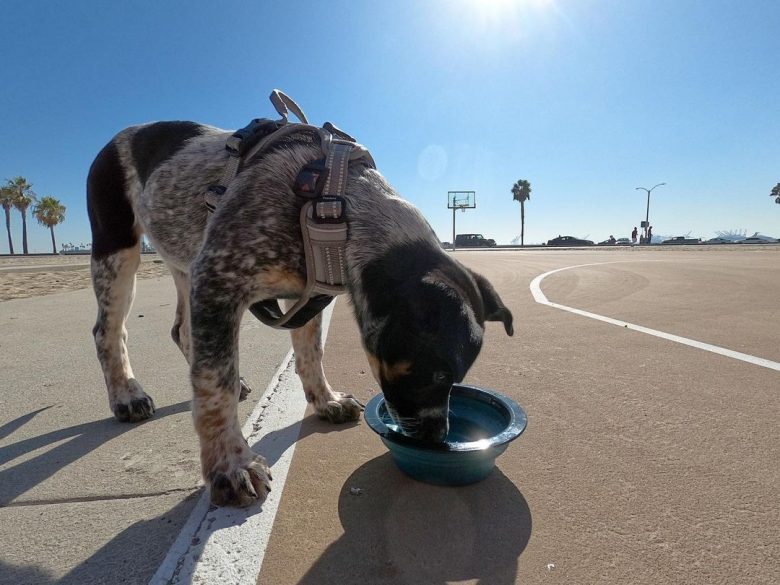
Just like its Lab parent, this doggo is prone to obesity, so overfeeding is a no-no. Depending on your pet’s activity level, size, and age, you should aim for 2.5 cups of dry dog food a day. Choose a high protein diet.
You can also check your dog’s weight by looking at them from overhead. She should have a defined waist, and you should be able to feel her last two ribs.
Being active is essential, not optional. They need one to two hours of vigorous exercise daily.
A leisurely walk wouldn’t be sufficient, but there’s also agility, herding, running, swimming, hiking, running alongside a bike, rollerblading, and retrieving.
Remember, one of the Labraheeler’s parents are bred to run next to a horse for hours, herding cattle in the heat and sun.
They won’t be happy being lazy on the couch and just sleeping all day. If your dog gets bored, they might turn to other things to do, like destroying furniture.
When it comes to grooming, the Blue Heeler Lab mix is a moderate to heavy shedder. Your pooch will require weekly brushing to get her hair under control. During shedding season, you’ll need to brush her fur every day.
For weekly grooming routines, check her ears and trim her nails. Baths should only be given every two months or when needed.
Dental hygiene is also important. Brush her teeth at least once a week with a dog-specific toothpaste and a two-sided toothbrush to make the job easier.
Lifespan: Are Australian Cattle Dog Lab mixes healthy?
Blue heeler lab mixes are relatively healthy and have a life expectancy of 10 to 16 years.
Did you know that one of the Guinness World Record holders for “oldest dog” was a Blue Heeler named Bluey, who died at the age of 29 in 1939?
But crossbreeds can still suffer from health problems that their purebred parents are predisposed to, like serious congenital issues. There’s also retinal atrophy, hip and elbow dysplasia, deafness, myopathy, heart disorders.
How much do Labraheelers cost?

Blue Heeler Lab mix puppies have a price range of $750 to $1,000. Costs are usually affected depending on the breeder’s location, the availability of puppies, the kennel’s popularity, etc.
You have to do your research first and find a reputable breeder. One who conducts interviews and provides questionnaires, as well as letting potential buyers visit and meet the pup’s parents and littermates.
A responsible breeder will also voluntarily show you the documents about the puppy’s bloodline and the parent’s health certificates and personality tests.
They’ll also take back the dog if you can’t keep it and keep you updated about the little fido.
Blue Heeler Lab mix breeders & rescues
We don’t recommend that you purchase from pet stores since there’s no proof that the pups didn’t come from puppy mills. Luckily, you can go online to look for breeders and kennels that offer puppies that you might like.
As of the moment, there are no specific breeders who are breeding or producing Labradors and Blue Heelers, but another option is adoption.
There’s Brentwood Labraheelers on Facebook, which offers different Labrador Retriever hybrids.
Since there’s no specific club or rescue that caters to this crossbreed, you can check Labrador and Australian Cattle Dog organizations that also take care of their corresponding mixes and are just waiting to be adopted.
- Unconditional Love Pet Rescue (Green Forest, AR)
- Australian Cattle Dog Rescue Association (Garden City, NY)
- Pacific Northwest Cattle Dog Rescue (Skagit County, WA)
- Lab Rescue LRCP (Annandale, VA)
- Fortunate Pooches and Lab Rescue (Palatine, IL)
If you really want this designer dog, you can either reach out to shelters or contact local Lab or Blue Heeler breeders or clubs to see if they have any leads on finding a friend for your family.
Other Blue Heeler mixes and Labrador hybrids
If you aren’t entirely sure that the blue heeler lab mix is the right dog for you, there are a few other breeds out there that have similar traits, size and include either the Lab or the Blue Heeler gene:
- German Shepherd Blue Heeler mix
- Blue Heeler Dachshund mix
- Blue Heeler Pitbull mix
- Pitbull Lab mix
- Husky Lab mix
- Beagle Lab mix
Make the Blue Heeler Lab mix a part of your life
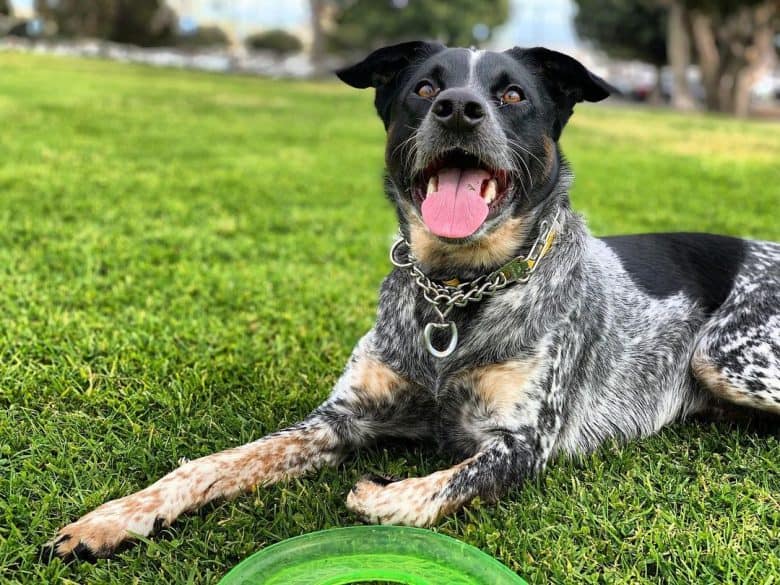
This pooch is pretty amazing, right? To help you decide whether this dog is for you, think about its good qualities and quirks. The pros are that they’re loyal, smart, people-oriented, and always up for fun.
The cons are that they’re high energy (though this may be a good thing, depending on your lifestyle), they may try to herd other pets or family members, and they may sometimes be suspicious of strangers.
But in the right household, this can be the perfect pet.
What are your thoughts about the Blue Heeler Lab mix? Tell us about your thoughts and stories, if you have a Labraheeler, by leaving a comment below.
Reference
- https://www.nationalgeographic.com/animals/mammals/facts/dingo
- https://www.scottishcolliepreservationsociety.com/breed-history.html
- https://www.guinnessworldrecords.com/world-records/oldest-dog
Cess is the Head of Content Writing at K9 Web and a passionate dog care expert with over 5 years of experience in the Pet Industry. With a background in animal science, dog training, and behavior consulting, her hands-on experience and extensive knowledge make her a trusted source for dog owners.
When not writing or leading the K9 Web content team, Cess can be found volunteering at local shelters and participating in dog-related events.
